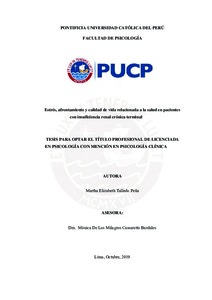| dc.contributor.advisor | Cassaretto Bardales, Mónica de los Milagros | es_ES |
| dc.contributor.author | Talledo Peña, Martha Elizabeth | es_ES |
| dc.date.accessioned | 2019-11-21T15:26:46Z | es_ES |
| dc.date.available | 2019-11-21T15:26:46Z | es_ES |
| dc.date.created | 2019 | es_ES |
| dc.date.issued | 2019-11-21 | es_ES |
| dc.identifier.uri | http://hdl.handle.net/20.500.12404/15371 | |
| dc.description.abstract | El objetivo principal de este estudio es identificar cuáles variables predicen la salud
física y la salud mental en un grupo de 100 pacientes que reciben tratamiento de
hemodiálisis, cuyas edades oscilaban entre 21 y 70 años (M=53.07; DE=11.56). Se
utilizó la escala de estrés percibido EEP-14 creada por Cohen, Kamarck y Mermelstein
(1983), el inventario multidimensional de estimación del afrontamiento COPE-60
diseñado por Carver, Scheier y Weintraub (1989) y cuestionario de salud SF-36, versión
1 realizado por Ware y Sherbourne (1982). Los resultados sugieren que la CVRS física
está más deteriorada, específicamente en las dimensiones del rol físico y salud general.
Se observaron relaciones significativas entre el estrés percibido y todas las relaciones de
CVRS. El componente salud mental relacionó negativamente con el estrés percibido
total, además de las estrategias de afrontamiento de contención, supresión de
actividades, enfocar y liberar emociones, búsqueda de soporte por razones emocionales
búsqueda de soporte por razones emocionales, desentendimiento conductual y uso de
sustancias. El componente de salud físico correlacionó negativamente con el estrés
global y la estrategia de enfocar y liberar emociones. Se realizaron análisis de regresión
para cada componente de la CVRS, encontrando que el acceso vascular, la diabetes, y el
estrés global explican el 28 % de la variabilidad del componente físico. Mientras que la
hepatitis C, la diabetes, el estrés global y la estrategia de enfocar y liberar emociones
explicaron el 43% de la CVRS mental. | es_ES |
| dc.description.abstract | The main aim of the research was to identify which variables predict physical health and
mental health component in a group of 100 patients receiving hemodialysis treatment,
whose ages ranged between 21 and 70 years (M = 53.07; DE = 11.56). The perceived
stress scale EEP-14, created by Cohen, Kamarck and Mermelstein (1983), the
multidimensional inventory of coping estimation COPE-60 designed by Carver, Scheier
and Weintraub (1989) and health questionnaire SF-36, version 1 made by Ware and
Sherbourne (1982) were used for the measurement. Results, revealed that physical
HRQoL is more impaired, specifically in the dimensions of physical role and general
health. Significant relationships between perceived stress and all dimensions of HRQoL
relationships were observed. The mental health showed negative correlations with
restraint coping strategies, suppression of activities, focus on and venting of emotions,
seeking social support for emotional reasons, behavioral disengagement and
consumption of substances. The physical health component correlated negatively with
global perceived stress and the strategy of focus on and venting of emotions. Regression
analyzes were performed for each component of the HRQoL. Results showed that
vascular access, diabetes, and global stress account the 28 % of the variability of the
physical health component. Meanwhile, hepatitis C, diabetes, global perceived stress
and the strategy of focus on and venting of emotions, accounted the 43 % of the
variability of the mental health component. | es_ES |
| dc.language.iso | spa | es_ES |
| dc.publisher | Pontificia Universidad Católica del Perú | es_ES |
| dc.rights | info:eu-repo/semantics/openAccess | es_ES |
| dc.rights.uri | http://creativecommons.org/licenses/by/2.5/pe/ | * |
| dc.subject | Insuficiencia renal crónica | es_ES |
| dc.subject | Hemodiálisis | es_ES |
| dc.subject | Stress (Psicología) | es_ES |
| dc.subject | Adaptación (Psicología) | es_ES |
| dc.title | Estrés, afrontamiento y calidad de vida relacionada a la salud en pacientes con insuficiencia renal crónica terminal | es_ES |
| dc.type | info:eu-repo/semantics/bachelorThesis | es_ES |
| thesis.degree.name | Licenciado en Psicología con mención en Psicología Clínica | es_ES |
| thesis.degree.level | Título Profesional | es_ES |
| thesis.degree.grantor | Pontificia Universidad Católica del Perú. Facultad de Psicología | es_ES |
| thesis.degree.discipline | Psicología con mención en Psicología Clínica | es_ES |
| renati.advisor.dni | 09491245 | |
| renati.advisor.orcid | https://orcid.org/0000-0002-4880-6092 | es_ES |
| renati.discipline | 313026 | es_ES |
| renati.level | https://purl.org/pe-repo/renati/level#tituloProfesional | es_ES |
| renati.type | http://purl.org/pe-repo/renati/type#tesis | es_ES |
| dc.publisher.country | PE | es_ES |
| dc.subject.ocde | https://purl.org/pe-repo/ocde/ford#5.01.00 | es_ES |






